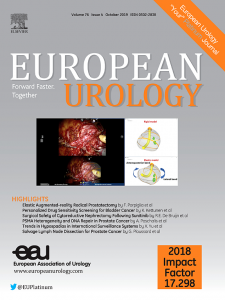卡介苗-谷氨酰胺无反应性膀胱原位癌治疗的成本-效果分析
IF 25.2
1区 医学
Q1 UROLOGY & NEPHROLOGY
引用次数: 0
摘要
背景与目的对于不适合或拒绝根治性膀胱切除术(RC)的“卡介苗无反应性”疾病患者的治疗选择正在扩大。由于缺乏直接的比较数据,我们进行了成本-效果分析来指导治疗选择。方法建立马尔可夫决策分析模型,对RC、纳伐拉真、诺加潘德金、派姆单抗和吉西他滨/多西他赛5种治疗方案进行评价。从美国医疗保险的角度,使用每个质量调整生命年10万美元的支付意愿阈值来评估5年期间的成本效益。对3例bcg无反应原位癌(CIS)患者进行评价。主要发现和局限性对于第1例患者,他愿意尝试一线治疗或直接进入RC,吉西他滨/多西他赛是最具成本效益的选择。对于指数患者2,开放两线治疗或前期RC, RC是最具成本效益的。对于指数患者3,在RC之前愿意尝试多达两种美国食品和药物管理局(FDA)批准的治疗(派姆单抗,纳多法拉金或诺加彭德金),派姆单抗是最具成本效益的选择。结论和临床意义目前保膀胱治疗的定价对bcg无反应的CIS患者造成了巨大的经济障碍。吉西他滨/多西他赛在RC前仅考虑一种治疗方案时最具成本效益,尽管这因临床情况而异。对于想要尝试两种疗法的患者来说,前期RC是最具成本效益的。对于只愿意尝试fda批准的方案而不愿意接受前期RC的患者,派姆单抗是最具成本效益的选择。我们的研究结果强调需要更好的治疗选择工具和更公平的定价。本文章由计算机程序翻译,如有差异,请以英文原文为准。
Cost-effectiveness Analysis of Treatments for Bacillus Calmette-Guérin–unresponsive Carcinoma in Situ of the Bladder
Background and objective
Treatment options for patients with “bacillus Calmette-Guérin (BCG)-unresponsive” disease who are ineligible for or refuse radical cystectomy (RC) are expanding. Given the lack of direct comparative data, we conducted a cost-effectiveness analysis to guide treatment selection.Methods
We developed a Markov decision analytic model to assess five treatments: RC, nadofaragene, nogapendekin, pembrolizumab, and gemcitabine/docetaxel. Cost effectiveness was evaluated over a 5-yr period using a willingness-to-pay threshold of $100 000 per quality-adjusted life year from the US Medicare perspective. Three index patients with BCG-unresponsive carcinoma in situ (CIS) were assessed.Key findings and limitations
For index patient 1, who is willing to try one line of therapy or proceed directly to RC, gemcitabine/docetaxel was the most cost-effective option. For index patient 2, open to two lines of therapy or upfront RC, RC was most cost effective. For index patient 3, willing to try up to two lines of US Food and Drug Administration (FDA)-approved therapy (pembrolizumab, nadofaragene, or nogapendekin) before RC, pembrolizumab was the most cost-effective option.Conclusions and clinical implications
Current pricing of bladder-sparing treatments poses significant financial barriers for patients with BCG-unresponsive CIS. Gemcitabine/docetaxel is most cost effective when only one therapy line is considered before RC, although this varies by clinical scenario. Upfront RC is most cost effective for patients wanting to try up to two lines of therapy. For patients only willing to try FDA-approved options and unwilling to undergo upfront RC, pembrolizumab is the most cost-effective option. Our findings highlight the need for better treatment selection tools and more equitable pricing.求助全文
通过发布文献求助,成功后即可免费获取论文全文。
去求助
来源期刊

European urology
医学-泌尿学与肾脏学
CiteScore
43.00
自引率
2.60%
发文量
1753
审稿时长
23 days
期刊介绍:
European Urology is a peer-reviewed journal that publishes original articles and reviews on a broad spectrum of urological issues. Covering topics such as oncology, impotence, infertility, pediatrics, lithiasis and endourology, the journal also highlights recent advances in techniques, instrumentation, surgery, and pediatric urology. This comprehensive approach provides readers with an in-depth guide to international developments in urology.
 求助内容:
求助内容: 应助结果提醒方式:
应助结果提醒方式:


